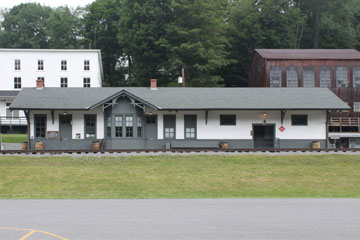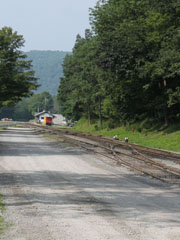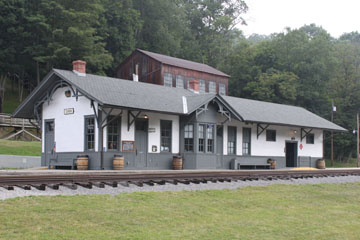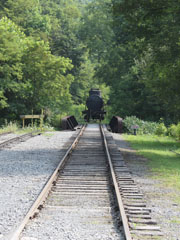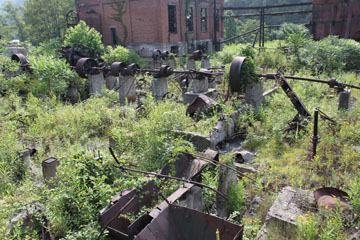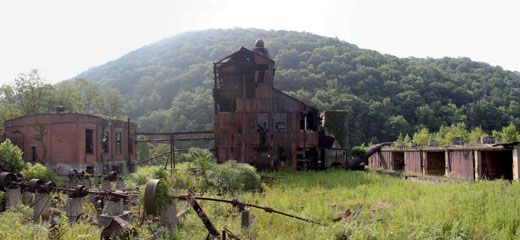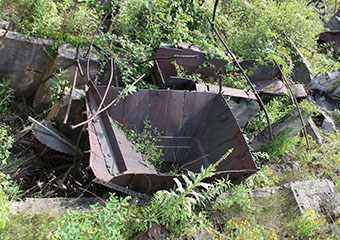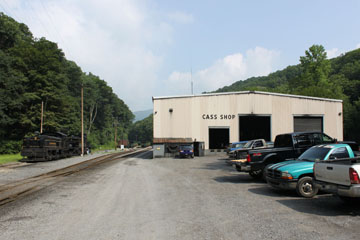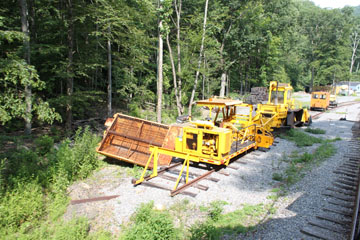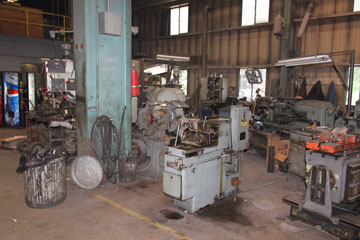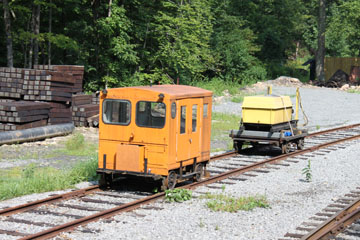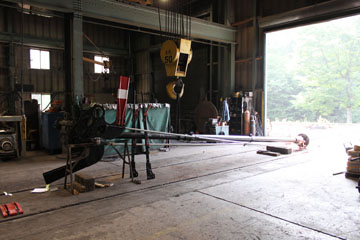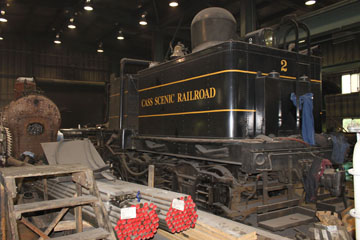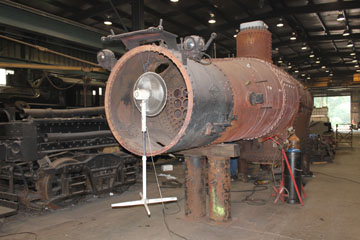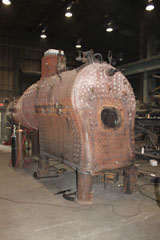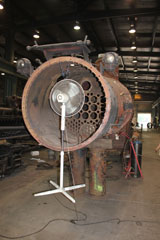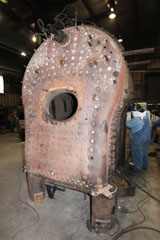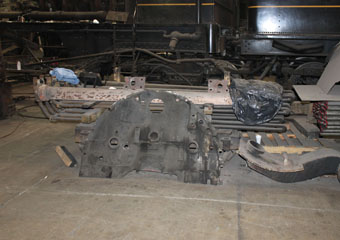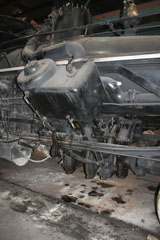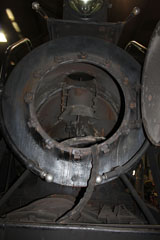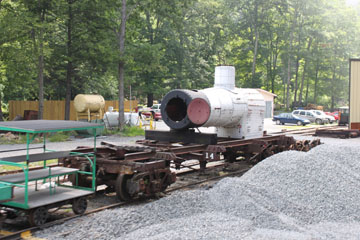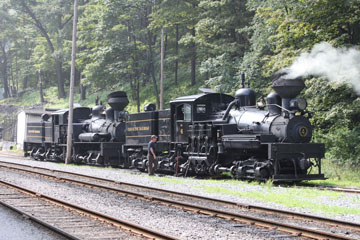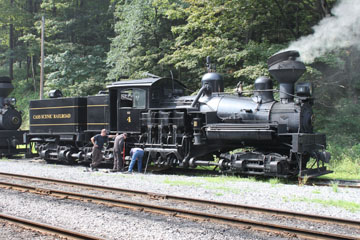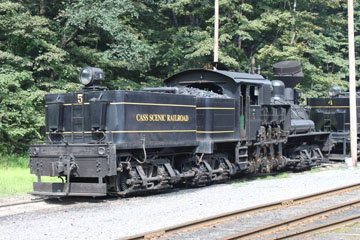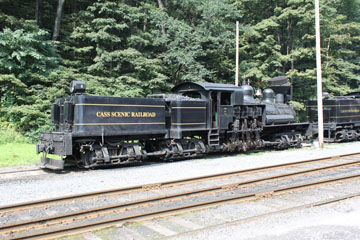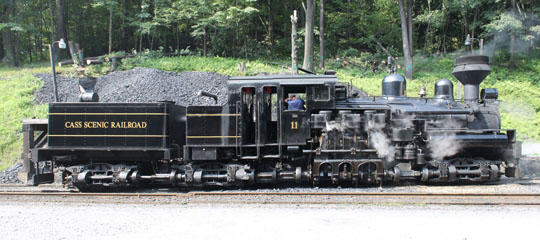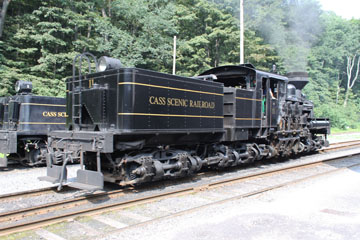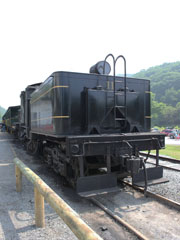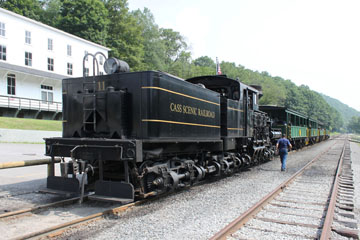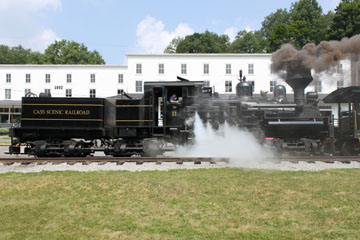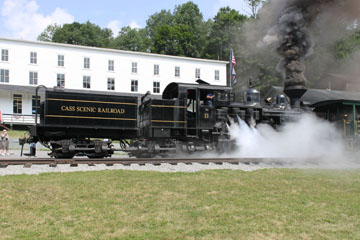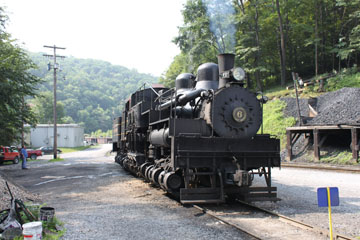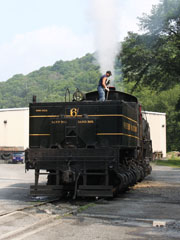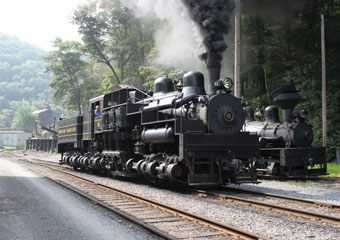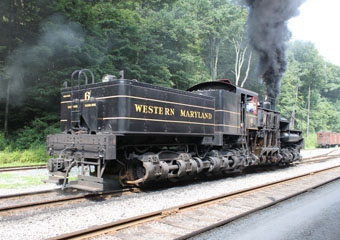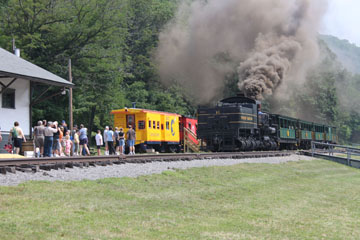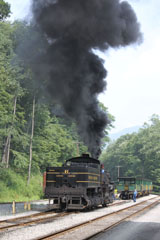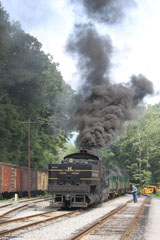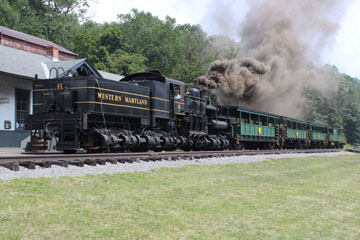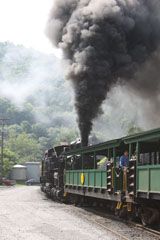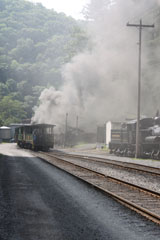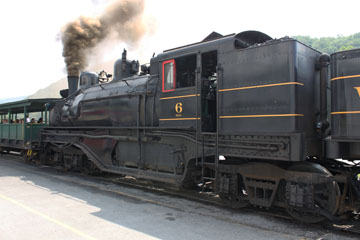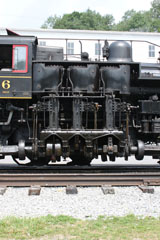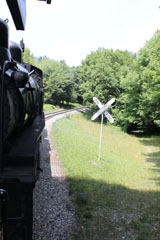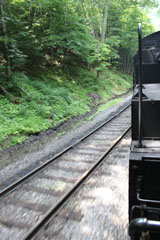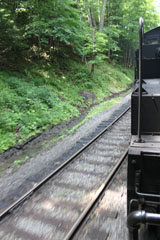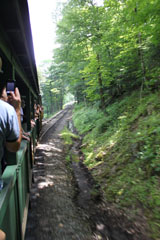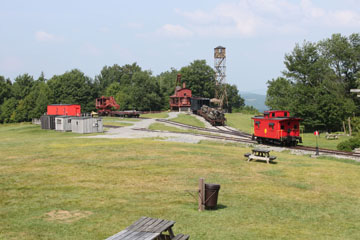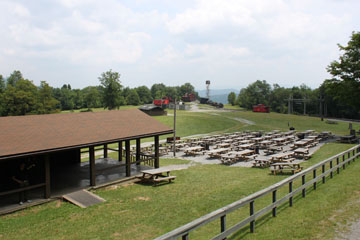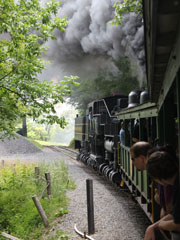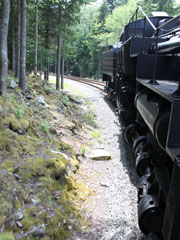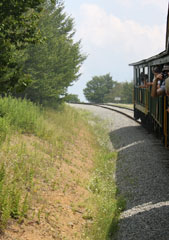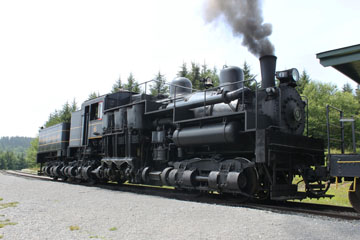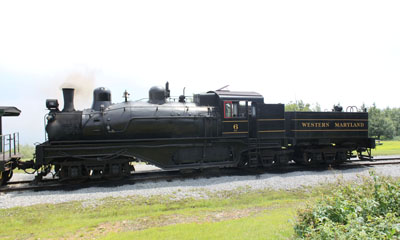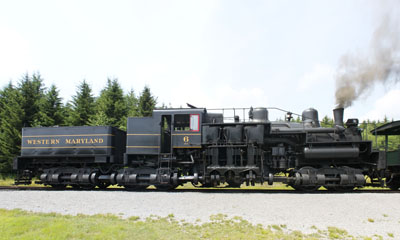

Cass Scenic Railroad is a State Park in Pocahontas County, WV. It comprises an eleven mile long railroad track and grade, the former company town of Cass and part of the summit of Bald Knob.
The railroad owns eight Shay locomotives, one Heisler and one Climax. It operates three trips: a two hour round trip to Whittaker Station, a five hour round trip to the abandoned site of the ghost town of Spruce and a five hour round trip to Bald Knob, the third highest point in West Virginia.
When I visited, I rode to Bald Knob and back behind CSRR #6, the last and second largest Shay locomotive ever built.

Left, the current depot was constructed in the late 1970s after the 1923 depot burned down in 1975. The original depot had been replaced in 1923 because it was no longer large enough.
The new depot is based on a standard Chesapeake & Ohio design.
Cass was founded in 1901 to house workers logging nearby Cheat Mountain for the West Virginia Pulp and Paper Company. It was named for Joseph Kerr Cass, Vice President and co-founder of the company. Located at an interchange between the Greenbrier & Elk River Railroad and the Chesapeake & Ohio, it became the centre of a shifting network of logging lines.
At its peak, the company employed 2,500-3,000 workers and, in an average week, the railroad shipped six to ten carloads of supplies to twelve separate logging camps.
Above, part of the old C&O Greenbrier Division running through Cass from Whitcomb to Winterburn, WV.
Moore Keppel #3, one of only three operational Climax locomotives, still runs over part of the old division. You can see it on the Durbin Rocket page of this website.

The remains of the old sawmill are about a half mile north of the depot.
The first sawmill began operating here in 1902. By the 1920s, it
employed more than 150 workers on two eleven hour shifts six days a week, processing 100,000 board feet of lumber each shift.
The Log Pond was just beyond the race in the photo above in the area now overgrown with trees. The sawmill occupied the open space between the railroad tracks and the old Powerhouse on the right. Logs were lifted from the pond to the mill by a mechanical Jack Slip.
The sawmill was rebuilt after a fire in 1922 and
was in service until 1960 when operations ceased. The building suffered major fires in 1978 and 1982, and all that now remains (below) are rusted pipes and the old belt pulleys that powered the machinery.
Cured timber was moved from the drying kilns to an adjoining planing mill three stories high and measuring 96' by 224'. Huge elevators lifted up to 5,000 feet of lumber at a time to the different floors, and some of the machines in the planing mill were so big that it took fifteen men to operate them. The finished timber was then moved to an adjacent flooring warehouse or out onto docks ready for shipping by rail.
Below, the remains of the planing mill. The flooring warehouse occupied the space between the planing mill and road bed in this photo.
Above, the Powerhouse is on the left. A steam engine in this building powered the belts and pulleys for the sawmill. It also provided electricity for the township.
Above centre (and photo on the left), the Boiler House contained four boilers to provide power to other parts of the mill. The Sorting and Grading Room and a large transfer table occupied the open area in front of the Boiler House. From there, milled timber was transferred to the drying kilns (on the right in the photo above).
A storehouse stood between the sawmill and railroad tracks. Up until 1942, it was where pulpwood was prepared for shipping to a paper mill at Covington, WV.
On the right, muddled remains of the sawmill and pulpwood operation.
Right, the station car park has been built over the site of old docks.
At the height of operations, 1½ million feet of lumber was shipped out from here each week and, every morning, a forty-four car pulpwood train left for the company's paper mill in Covington.
Both the mill, railroad and its equipment were owned by the West Virginia Spruce Lumber Company or its parent, the West Virginia Pulp and Paper Company until 1942. By then, much of the first growth timber had been milled out of the Cheat and Back Allegheny Mountains and, that year, the Mower Lumber Company acquired the operation to take advantage of second growth timber. However, this was a short lived reprieve.
By 1950, the new operation was in decline, and the sawmill was working only one shift. Following the owner, Edwin Mower's death in 1955, family members struggled to keep the concern going and, on 1st July 1960, both the mill and associated rail operations abruptly ceased. Three months later, Walworth Farms acquired the company, its equipment and landholdings with a view to disposing of them.
Still, it was not long before interest grew in preserving the railroad operation and, largely through the efforts of rail fan Russel Baum of Sunbury, PA, in 1961, the track and three locomotives were brought into the state park system. Work began on restoring the equipment but it was not until 1963 that the first steam excursion ran. Since then, the railroad operation has flourished, although the mill continues to deteriorate.



Above, the coaling station on the west side of the yard. Although a number of the locomotives in the railroad's collection were built as wood burners, they now all burn coal.
Below, the main shop. The original shop complex built in 1922, was initially leased from the Mower Lumber Company but was eventually purchased outright. It burned down in 1972 and the new complex was built consisting of a locomotive and machine shop, passenger car shop and a restoration building where volunteers are working on restoring CSRR Heisler #6.
Below, inside the main shop. Since 1972, this fully equipped workshop is where locomotives and much of the operating equipment has been worked on by Cass employees. Tours of the yard and shop to see how the rare geared locomotives are maintained by the shop crew are available daily. There are also tours of the old company town of Cass for visitors who would like to learn more about the historic township and its associated lumber industry.
In the lower photo, one of the track side signals is being overhauled in the main shop.
Even with eleven miles of track, the Cass rosters a number of maintenance of way vehicles.
Top, a Camron Railgroup Model 8VIJWI Ballast Tamper. Acquired via State Surplus from North Carolina in 1999, its build date and history are unknown. Lower photo, an ex-B&O section car. It was used in and around Fairmont, WV, for many years before being retired at an unknown date. It was purchased by D&H Welding Co., of Fairmont and then by the Mountain State Railroad & Logging Historical Association in 1991. It was eventually bought by the Cass in 2005.
The first logging tracks were laid from the present site of the Cass shops in 1900 up along the Leatherbark Creek on the west flank of Back Allegheny Mountain to a camp called Old Spruce. Four years later, the line was extended from Old Spruce to Spruce, a new town on the Shavers Fork of the Cheat River. From Spruce, the track eventually ran thirty-five miles south into the Elk River Basin to Bergoo and sixty-five miles north along Shavers Fork. At Spruce a large pulp peeling mill was constructed, and billions of board feet of logs passed through the town.
From 1905, the railroad went through a series of name changes. The Greenbrier & Elk River Railroad became the Greenbrier, Elk & Valley Railroad in 1909, then the Greenbrier, Cheat & Elk Railroad the following year, although West Virginia Pulp & Paper owned the entire railroad and lumber operation from their beginnings through the West Virginia Spruce Company. When West Virginia Pulp & Paper bought out its West Virginia Spruce operation on paper in 1910, the railroad became a common carrier.
Spruce began to decline when the mill
closed in 1925. In 1927, the Greenbrier, Cheat & Elk was sold to the Western Maryland Railroad and then paid a set rate to use the tracks. In the early 1930s, Spruce became an isolated helper station on the Western Maryland then, with dieselisation, all locomotives serving Cass transferred to Laurel Bank and Spruce became a ghost town. Finally, some time in the 1950s, Mower Lumber built a line from Old Spruce to Bald Knob, the last part of the present logging railroad.

Built as a wood burner, this 3-truck Pacific Coast Shay was converted to burn oil before going to Mayo Lumber and then rebuilt to burn coal at Cass. It is the only known Shay to have used all three types of fuel.
#2 ended its career switching cars on the Vancouver docks in 1970, making it one of the last commercially operated Shays in the world.
When I visited, CSRR #2 was being overhauled.
#2 was built in 1928 as a stock locomotive by Lima. At some point soon after, it was sold to the Mayo Lumber Company of Paldi, Vancouver Island, BC, where it was numbered #4. In 1943, it was bought by the Lake Logging Co., at Cowichan Lake, BC, and renumbered #5. Three years later, it went to Western Forest Industries at Honeymoon Bay, BC, and then to Railway Appliance Research Ltd., at North Vancouver, BC, as #114. It was leased to Vancouver Wharves before being purchased by the Cass in 1970.
Produced in the 1920s and
1930s, Pacific Coast Shays were more powerful versions of standard 3-truck Shays: #2 is superheated, has a 13" longer firebox, lower gear ratio, steel cab, cast steel trucks and a steel girder frame.
The steel girder frame had a larger opening than the standard I-beam frame to allow access to the locomotive's staybolts.

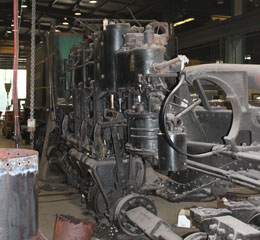
As is evident in the photo above,
the 13" x 15" cylinders were designed so they attached to the locomotive frame, rather than to the boiler shell as in standard Shays. This allowed for easier access and maintenance.
#2 is the only Pacific Coast Shay in the eastern US. It weighs 186,000 lbs, has 36" drivers and operates at a boiler pressure of 200 psi delivering 38,200 lbs tractive effort.
Left, one of the workmen drills staybolts. Above, #2's replacement flues and tubes lie waiting to be installed. It was last reflued as recently as May 2002.
#2 made its operational debut on the Cass Scenic Railroad in May 1972 burning No. 4 diesel fuel. For the next eleven years, it normally hauled the regular excursion trains to Bald Knob. In May 1983, it re-entered service after being converted to burn coal and having its original shotgun stack replaced by a diamond stack.


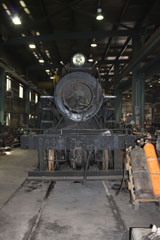

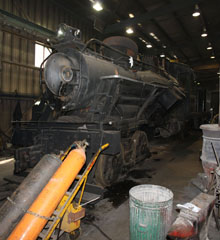
Above, CSRR 3-truck Heisler #6 was also in the shop.
This locomotive was outshopped from the Heisler Locomotive Works in Erie, PA, in 1929 as #20 for the Bostonia Coal & Clay Products Company in New Bethlehem, PA. Unusually, it was built as a saturated steam engine well into the superheated era. In 1939, it was sold to the Meadow River Lumber Company at Rainelle, WV, where it was renumbered #6.
Left, #6 has 40" drivers. Above left, the central drive shaft connects to each truck through a universal joint to allow the locomotive to turn on sharp curves. Above right, the cylinders are 18¼" x 16" (note the cam used to transfer power to the drive shaft).
A coal burner, #6 weighs 180,000 lbs, operates at a boiler pressure of 200 psi and delivers 22,650 lbs tractive effort.
#6 was bought in 1967 for $20,000 and ran under its own steam to Cass.
It has operated successfully on the Whittaker Station Train since May 1968, and has been used on a number of off-line trips because of its greater speed.


CSRR Climax #9 was out in the yard when I
visited. Built for Moore Keppel & Company at Ellamore, WV, in 1919 as #6, it transferred to the Middle Fork Railroad in 1930 and was then sold to Robert L. Johnson, of Rossville, GA, in 1967. The State of West Virginia bought the locomotive in 1970.
This 3 truck Climax weighs 140,000 lbs, has 14½" x 16" cylinders and 35" drivers. Operating at a boiler pressure of 200 psi, it delivers 30,800 lbs tractive effort. #9 is one of only two Moore Keppel Climaxes to survive. You can see the other, #3, still steaming, on the Durbin Rocket page of this website.


This 3-truck Shay was built for the Birch Valley Lumber Company at Tioga, WV, as #5 in 1922. In 1943 it was sold to the Mower Lumber Company and renumbered #4. Following the demise of Mower Lumber, the locomotive was sold for scrap to the Midwest Raleigh Corporation in 1961. However, with the impending purchase of the railroad by the State of West Virginia, #4 was spared the torch and used to provide free demonstration runs between Cass depot and the shop during September and October 1961. It was finally sold to the State of West Virginia in 1962.
#4 has classic early Shay arch cab windows. It weighs 170,000 lbs, has 12" x 15" cylinders and 36" drivers. A coal burner operating at a boiler pressure of 200 psi, it delivers 30,350 lbs tractive effort.
#4 hauled its first excursion in June 1963, and powered the first off-line excursion to the Mountain State Forest Festival in Elkins, WV, in October 1964. It also hauled the Bald Knob Inaugural, when the extension to Bald Knob
re-opened in May 1968. It now mostly serves as the Bald Knob pusher engine if required.


Built as #5 in 1905, this is the oldest surviving locomotive from the original Greenbrier & Elk River roster, and the second oldest Shay in continuous operation in the US. This 3-truck Shay has 13½" x 15" cylinders and 36" drivers.
It is a coal burner operating at a boiler pressure of 200 psi and delivering 35,100 lbs tractive effort.
#5 arrived in August 1905 and first ran on 11th November that year. Initially assigned to the Cass Hill, various assignments followed at Spruce and on Elk River but, because of its weight (180,000 lbs) and the deteriorating railroad, it saw little work after 1953. It was last used at the sawmill as a steam source during the "Big Freeze" in March 1958.
Like #4, #5 was eventually sold to the State of West Virginia in 1962 by the Midwest Raleigh Corporation. After considerable work to bring it back into service, it debuted on 5th May 1966 and worked for a number of years as helper on the Bald Knob run, then as lead engine from 1970 until 1972. Since then, it has undergone various shoppings and been in and out of service as needed.


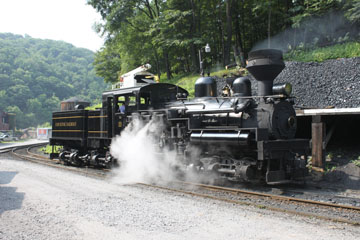

#3 was in good condition and, after some relatively light work, it entered service on 17th September 1999. The next day, it worked as a pusher on the Bald Knob run and continued in that role as needed until August 2000. A crankshaft problem then took it out of service and subsequent shopping included conversion to a coal burner. #3 returned to service at the start of the 2001 season as the Bald Knob road engine.
Weighing 204,704 lbs, with 14½" x 15" cylinders and 36" drivers, it operates at a boiler pressure of 200 psi delivering 40,400 lbs tractive effort.
Built in 1923, this 3-truck Shay originally went to the Hutchinson Lumber Company's Oroville, CA, mill as #3. Four years later, the operation was sold and the locomotive became Feather River #3, by which name it is still remembered. It then became Georgia-Pacific property when the logging operation and railroad were bought out in 1955, although it retained #3. The locomotive went on standby with the arrival of an EMD diesel in October 1961 and was finally retired in May 1965.
#3 was donated to the Pacific Southwest Railroad Museum Association (now the San Diego Railroad Museum) in May 1967. Fired up again in June 1969, the locomotive steamed on various occasions until 1991. It was eventually acquired by the State of West Virginia in May 1997, and was disassembled and trucked to Cass in October 1998.
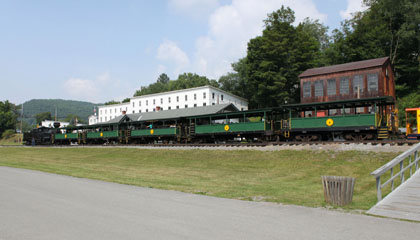
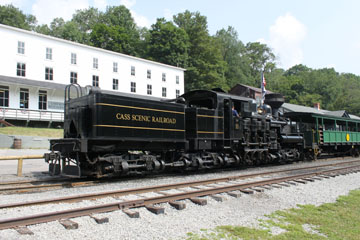
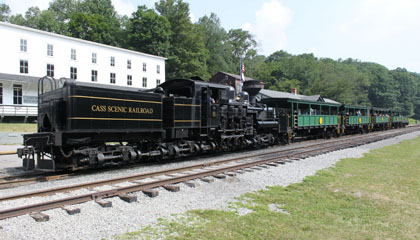
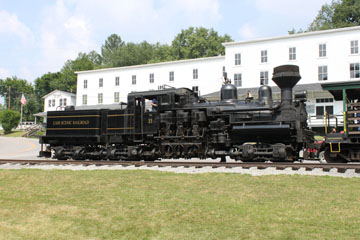
On the day I visited, #11 was hauling the Whittaker Station train.
Above, #11 stands at the Cass depot awaiting departure. Right, a series of shots as the locomotive starts out. On its four mile trip up to Whittaker Station, the train will climb 400 feet and negotiate curves of up to 29° as well as grades reaching 8.7%.

Below and right, 3-truck Shay #6 waits in the yard to assemble the Bald Knob train. It has just taken on water and coal.
This was the last Shay outshopped by the Lima Locomotive Works in Lima, OH. It is also the second largest Shay ever built and the largest still in existence.
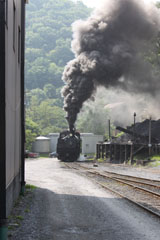

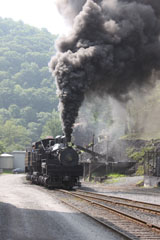
#6 had a service life of only four years and was then stored at Vindex, Maryland Junction and then Hagerstown, MD.
In 1953, it was donated to the B&O Railroad Museum, and ran under steam to Baltimore, MD, in August that year.
The locomotive remained on static display in the B&O Museum roundhouse for the next twenty-six years.
In 1981, an exchange was arranged with the museum for CSRR #1 (you can see #1
reliveried as Greenbrier, Cheat & Elk #1 on the B&O Museum Roundhouse page of this website) and ex US Army Porter 0-4-0T #714. #6 was moved onto the turntable and out of the museum using air generated by a compressor, pulled cold to Durbin and picked up there by CSRR Heisler #6.
Above, #6 pulls into the Cass depot.
#6 entered excursion service on 17th May 1981 on the former C&O Greenbrier Division to Durbin, but clearance restrictions and its 324,000 lb weight meant the locomotive was rarely used on the CSRR. Eventually, track upgrades permitted operation to Whittaker Station starting in June 1991. Then, rebuilding the mountain wye to circumvent the 36° mainline curve allowed the "Big Six" to run to Bald Knob. Subsequently, realigning the curve has permitted #6 to operate on the Bald Knob run without using the wye.
Built as a coal burner, #6 operates at a boiler pressure of 200 psi delivering 59,740 lbs tractive effort. The locomotive is roughly twice as big as any of the other CSRR locomotives, and nearly twice as powerful. It is assigned to excursions to Spruce and Elkins, as well as Bald Knob.
Below and right, #6 stands at Cass depot while the crew relax and await the train's departure. It will climb some 2,300 ft on the eleven mile run, negotiating a 29° curve before reaching Whittaker Station along the way and a 9% grade as it approaches Bald Knob.
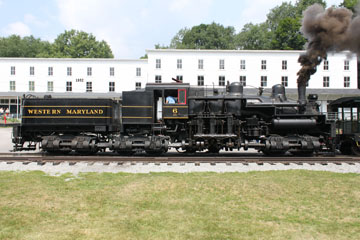
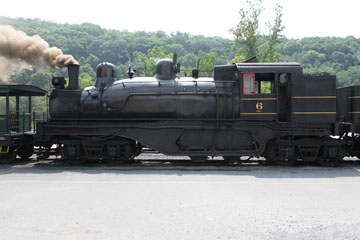

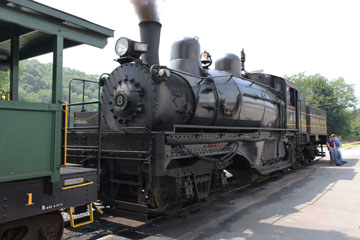

Above and right, #6 has three 17" x 18" vertically mounted cylinders. The crank shaft is connected to a longitudinal drive shaft by universal joints and square sliding prismatic joints to accommodate swivelling of the trucks.
Below, each truck has four 48" drive wheels.
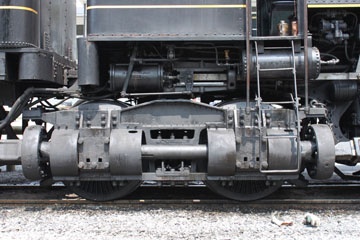
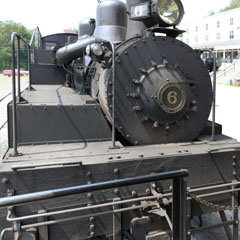

Taken from the deck of the first carriage, the photos above show the characteristically "lop sided" look of a Shay, as the boiler has to be offset to accommodate the side-mounted cylinders. The pipe on the left supplies live steam to the cylinders.
The photos also suggest the sheer size of #6, with its 62⅜" diameter extended wagon top boiler.

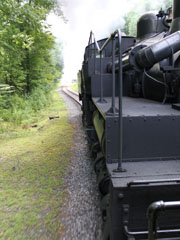
Above, just clear of the Cass shops and yard. #6 will push the train most of the way up to Bald Knob.
Below, crossing the first of two bridges across Leatherbark Creek. Originally wood stringers, both bridges were replaced with steel in the 1950s.
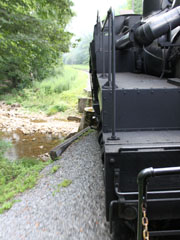
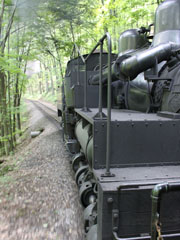
Above, climbing up Leatherbark Run, the train approaches the
first switchback on Cass Hill, 2.3 miles from the depot.
Below, the Whittaker Station train waits for the Bald Knob train to clear the switchback before it continues back down to Cass.
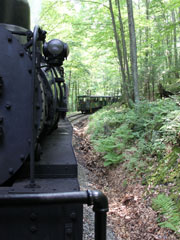
Below, leaving the first switchback. #6 now pulls the train forward until it reaches the second switchback.
The grade is 6.3% on the mile long climb to the next switchback.

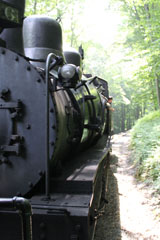
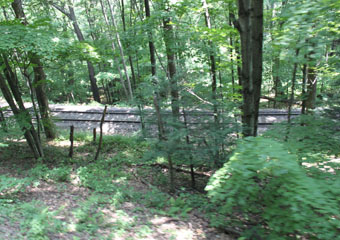
Above, looking back down to the track we just climbed to reach the first switchback.
Switchbacks were common on logging and mining railroads in mountainous regions, allowing track to gain elevation in relatively tight spaces.
Left, approaching Gum Curve.
The train will shortly turn to the right through a 158° arc. Starting at a 22° curve on a 3.65% grade and sharpening into a 29° curve on a 2.3%
grade, it is the
tightest curve on
Cass Hill.
Below, the train passes the Mile 3 marker as it approaches Limestone Cut.

Below, passing through Limestone Cut. The grade here is 6.7%.
The cut was hacked out by workmen using hand tools and black powder when the line was built in 1900.
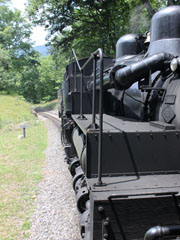
Below, looking back along the train as it switches onto the up track on the right.
From here, #6 will push the train the rest of the way to Bald Knob.
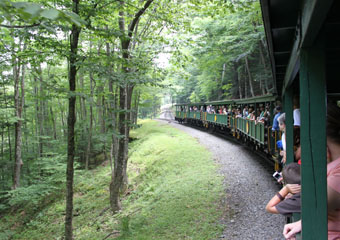
Below, a view looking back at the track we have just climbed.

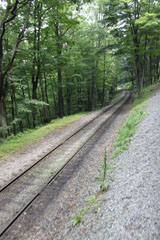
As it climbs the next half mile from here, #6 must push the train up one of the steepest climbs on the run: the grade reaches 8.7% on the last quarter of a mile before reaching Whittaker Station.

Above, climbing into Whittaker Station.
This was once the site of a construction camp when the railroad was being built, but is now the Mountain State Railroad & Logging Historical Association's Whittaker Camp One display.
A log loader built by the Meadow River Lumber Company at Rainelle, WV, is on the centre track. It is mounted on a Meadow River skeleton log car and coupled to an early steel flat car from Elk River Coal & Lumber in Swandale, WV. The remaining track holds a tower skidder originally assembled from older Lidgerwood engines and winches by the Meadow River Lumber Company.
A tower skidder carried logs on an aerial cable from distant logging sites to the railroad, where a loader would stack them on cars. When all usable timber had been cut from a site, the far end of the cable was moved so that eventually all the timber in a circular area around the skidder had been taken out. The skidder remained at the same location for several months.
There is also a ballast car, two flat cars and a four wheel, reportedly ex-B&O, bobber caboose.
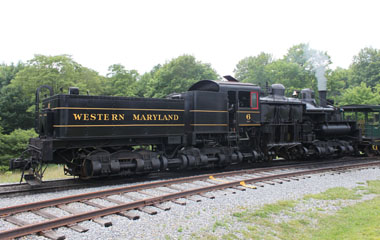
Above, #6 standing at Whittaker Station.
Right, the locomotive at the Mile 4 marker crossing a culvert over Whittaker Run. The old grade used to run off to the left from this point on a sharper curve. #6 really has to work to get the train moving after the stopover.
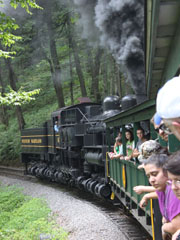

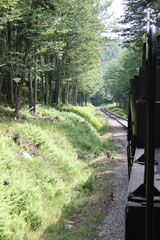


Above, leaving behind the crossing on Forest Road 267, an old logging road from the 1970s.
Below, Austin Meadows. Farm fields once came up to this spot, and a scenic overlook was originally planned to be built here.
Above, a view down Leatherbark Run to Thomas Mountain in Seneca State Forest. At this point, the train has travelled six miles from Cass and climbed 2,400 feet.
Left and below, the remains of old smokestacks dumped beside the track.
Above, the remains of a spur built in 1911 to Camp 5. It is one of many rail spurs built to haul lumber out of the forest. By the 1920s, the Greenbrier, Cheat & Elk had many branches and spurs. It built about two hundred and fifty miles of track in total, but probably about one hundred and forty miles were in use at any one time, including the eighty-two miles of mainline track.
Below, smoke rolls down Leatherbark Run as #6 pushes past the site of a 1996 washout that closed access to Bald Knob for almost a year. It cost over $1,000,000 to rebuild the grade here.
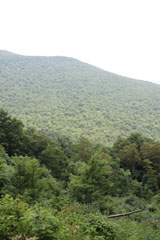

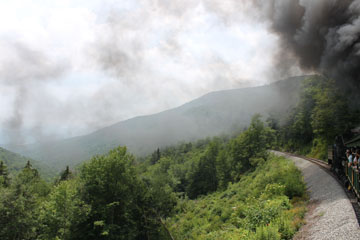
Below, the start of a grade built in Spring 1960 to the head of Leatherbark Creek.
The Monroe Lumber Company shut before any track was laid.

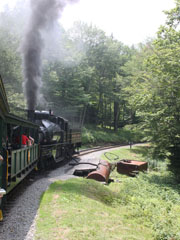
Above, #6 takes on water diverted into an old boiler shell at Oats Creek. The water is drawn using a siphon.
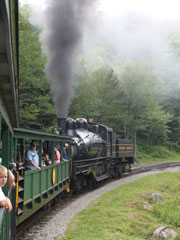
Above, #6 pulls away from Oats Creek.

Above, a view from the train up Snowshoe Overlook toward the head of Shavers Fork. This area was logged from 1902 until 1905, and again from 1945 until 1950.
The grade on this part of the track is 8%.
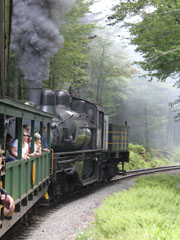

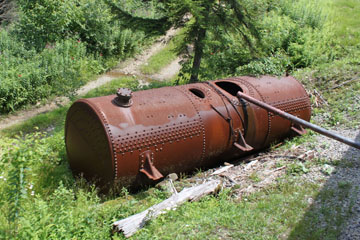
Above, #6 works hard to climb the 7% grade on Johnson Run.
Right and below, crossing over the wye. In 1950-51, a mile long logging spur ran north from this point to a logging train and five skidder sets. The section is now only a few hundred feet long.
Above, an old engine boiler shell serves as a water tank, although seldom used now. The road on the left is an old logging spur.
Below left, the remains of an old logging spur veers off to the north and loops round the summit of Bald Knob. In 1958-59, there were two skidder sets and a logging camp on the loop, the last
camp in full operation. Below right, the train approaches the stop at Bald Knob (the elevation marker is on the right of the track). At 9%, this short section of track is the steepest on the entire eleven miles.
Below, the marker beside the line shows the elevation at the Bald Knob observation platform.

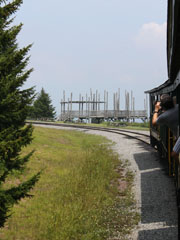
Above, a view as the train approaches the observation platform.
This is not actually the summit of Bald Knob, which is just to the south and 4,832' high.
Below, a skittish doe runs from the
commotion as the train climbs the last section of track.
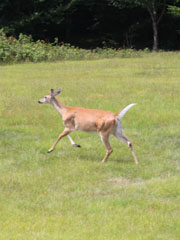
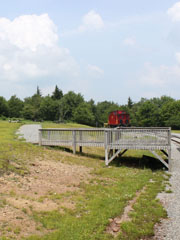
Above, approaching the end of the line.
There is a stopover at Bald Knob of about thirty minutes so passengers can enjoy views from the observation platform.

Above, looking south east across the valley of the Greenbrier from the observation platform.
Right and below, #6 standing at Bald Knob. It took two and a quarter hours to travel eleven miles and climb 2,300' from Cass, but it will take just over an hour to get back down.

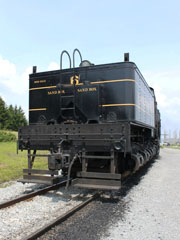
Related Links:
Cass Scenic Railroad State Park Website
Shay Locomotives Website
Send a comment or query, or request permission to re-use an image.
Philip V. Bagdon's Shay Logging Locomotives at Cass (TLC Publishing, 2001) and Kyle Neighbours' Lima Shays on the Greenbrier, Cheat & Elk (self published) provide comprehensive histories of the Cass locomotives (click on the cover to search for either of these books on Bookfinder.com).

Gerald Futej and Max Robin's Western Maryland Railway Shay No.6 (Linwood 2010) examines that locomotive in detail (click on the cover to search for this book on Bookfinder.com).



